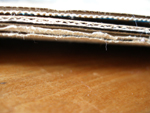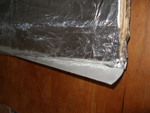Bulletin #7213, Maine Home Energy: Stop Window Drafts with Homemade Indoor Shutters
Developed by Extension Professor Kathy Hopkins, University of Maine Cooperative Extension. Reviewed by Extension Professor Donna Coffin, University of Maine Cooperative Extension.
For information about UMaine Extension programs and resources, visit extension.umaine.edu.
Find more of our publications and books at extension.umaine.edu/publications/.
Windows can account for a great deal of energy loss from your home. The U.S. Department of Energy estimates that heat loss through windows may account for 10 to 25 percent of your heating bill.1
Not all windows are created equal
The least efficient windows are single-paned with no storm windows. The most efficient windows are certified by the National Fenestration Rating Council and carry an NFRC label. Windows that carry the ENERGY STAR are certified by the NFRC to meet U.S. EPA and U.S. Department of Energy criteria for your climate zone.
Most of us are familiar with R-value, which measures insulating value—resistance to heat transfer. Windows, however, are rated by U-value, which is the inverse of R-value. U-value measures the rate of heat transfer through a substance—its conductivity. If you were buying insulation, you would want a product with a high R-value. If you were buying windows, you would want a product with a low U-value, indicating that you will lose less heat through your windows. In Maine, you would want windows with a U-value of 0.35 or less.2
Reducing heat loss from your current windows
If buying new windows is not in your immediate future and you still want to decrease your energy costs, there are some quick and easy ways to make the windows you have lose less energy.
First, clean, caulk, seal, and lock your windows. Locking the window will keep the sashes in the frame where they belong, and help keep either sash from working its way open even slightly. If you have shades or heavy curtains, secure them to the window frame at night with painters tape, draft stoppers, draft snakes, magnetic tape, or hook and loop tape. Add a cornice, valance, or lightweight draft stopper to the top of the curtain rod or shade roller. This will keep warm ceiling air from dropping down across the glass and losing its heat to the cold window.
Instructions for removable indoor shutters
While sunny windows, especially if they are south-facing, can help warm a room during the day, they can be a source of heat loss at night or on cloudy days. Here is a thrifty practice worth reviving: you can make your own removable indoor shutters to reduce nighttime heat loss. All you need are some simple tools and easily available materials.
|
|
|
|
|
|
|
|
|
|
|
|
This simple shutter is easy and inexpensive to make. It can help you reduce your heating bill and be more comfortable in your home this winter. You can also use your shutters in the summer to reflect sunlight from your windows and keep your house cooler.
1, 2 U.S. Department of Energy’s Office of Energy Efficiency and Renewable Energy, “Windows,” Energy Savers (2010). http://www1.eere.energy.gov/consumer/tips/windows.html.
Information in this publication is provided purely for educational purposes. No responsibility is assumed for any problems associated with the use of products or services mentioned. No endorsement of products or companies is intended, nor is criticism of unnamed products or companies implied.
© 2008, 2012
Call 800.287.0274 (in Maine), or 207.581.3188, for information on publications and program offerings from University of Maine Cooperative Extension, or visit extension.umaine.edu.
The University of Maine is an EEO/AA employer, and does not discriminate on the grounds of race, color, religion, sex, sexual orientation, transgender status, gender expression, national origin, citizenship status, age, disability, genetic information or veteran’s status in employment, education, and all other programs and activities. The following person has been designated to handle inquiries regarding non-discrimination policies: Sarah E. Harebo, Director of Equal Opportunity, 101 North Stevens Hall, University of Maine, Orono, ME 04469-5754, 207.581.1226, TTY 711 (Maine Relay System).





